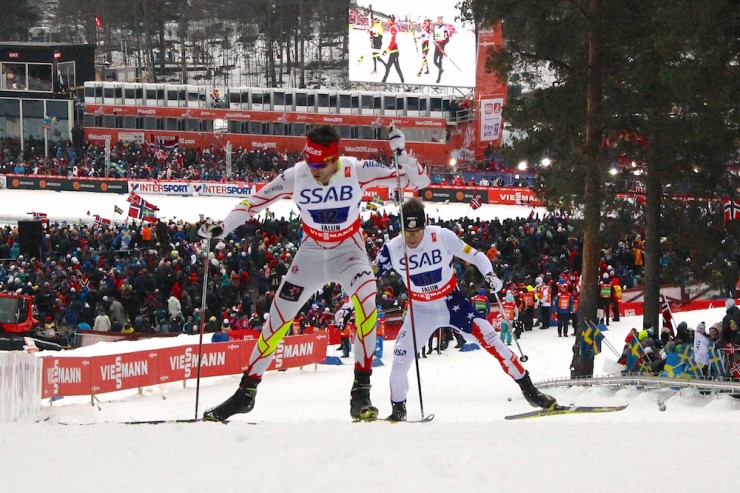
FasterSkier’s coverage of the 2015 FIS Nordic World Ski Championships in Falun, Sweden, is brought to you by the generous support of L.L. Bean, now featuring a complete line of Kikkan Randall training wear.
FALUN, Sweden — It was a North American battle royal in Sweden as the the U.S. and Canada dueled in the last leg of the men’s 4 x 10-kilometer relay at the 2015 FIS Nordic World Ski Championships. American Simi Hamilton attempted to ditch his Canadian counterpart on the climbs while Lenny Valjas tried to lose the Amercian on the downhills – both to no avail. Ultimately, North American relay supremacy was decided in the final meters as Valjas out-sprinted Hamilton to the line.
Ahead of the North Americans Norway defended its 2013 relay title with Petter Northug finishing with a time of 1:34:18.5. He bested Calle Halfvasson by just 0.6 seconds to give Sweden its second silver medal of the Championships. France provided an inspiring performance to repeat the nation’s bronze medal showing from the 2014 Olympic games.
Canada and the U.S. finished 3:03.5 and 3:04.9 behind the Norway to take 10th and 11th.
While the two North American nations are close friends and training partners, they’ve always been friendly competitors. Canada’s two time medalist in Falun and starter of the relay’s scramble leg said that he and his team entered the competition with two goals – improve on their 12th place finish at the 2014 Olympics and beat the U.S. team.
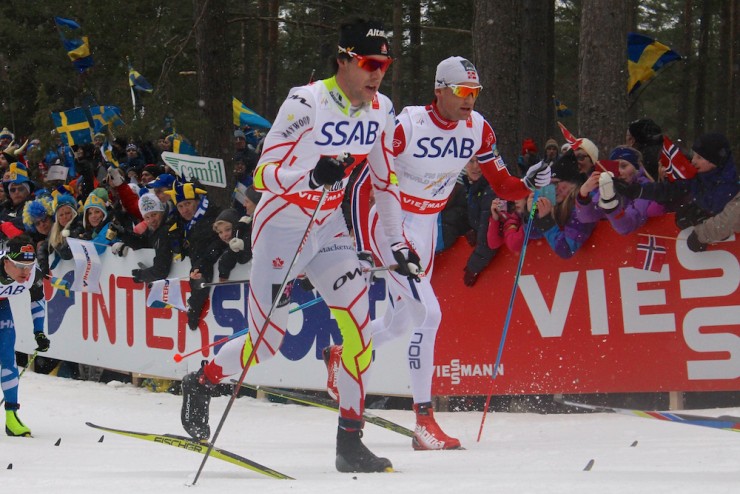
Early in the race it appeared that Canada had secured its goals, as Harvey skied at the front of the 10 k leg. The Quebec skier, who is hoping to earn another podium the weekend’s 50 k, said he used the relay as preparation for Sunday as he hasn’t raced since claiming bronze in last week’s 30 k skiathlon.
Harvey explained his body responded well to the effort and decided to hang on to to Russia’s Maxim Vylegzhanin and Norway’s Niklas Dyrhaug when they made a move on Mördarbacken, otherwise known as ‘Murder Hill’. As the pack entered the stadium and readied to tag off to their respective teammates, Harvey took advantage of superior skis and gave his teammate Graeme Killick a slight lead over the field of seventeen teams.
“It was really scary going out first,” Killick said of his 1.3 second lead. “ [It was] a really tough pace there right off the start.”
Killick managed to stay with the leading pack for the first half of his leg, but by the 6.5 k mark he trailed by over 30 seconds. “The plan was not to blow up, but eventually it was a bit too much up Mörderbacken,” he said, explaining that once he lost contact his main objective was to ski smooth and relaxed.
With Killick quickly losing time on the leaders, the American team began to make their advance.
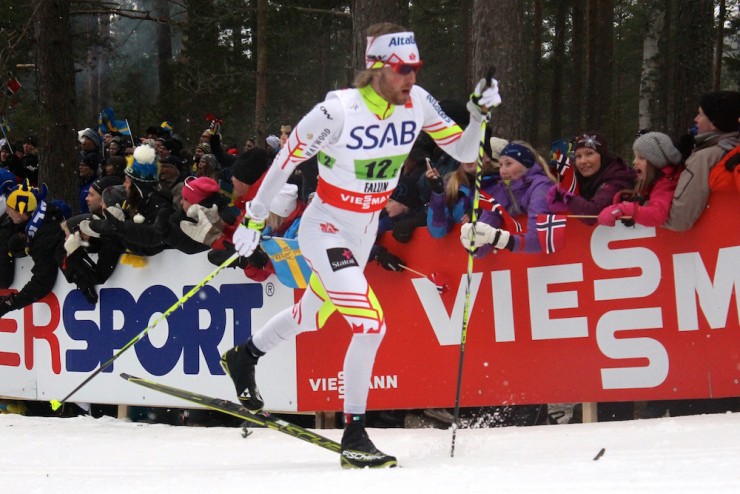
In the relay’s first leg, U.S. scrambler Erik Bjornsen skied between fifth and tenth to keep the U.S. in contact with the leaders. As the top skiers’ speed increased the 23-year-old was dangerously close to losing the advantage of the pack. The American gave several strong pushes to match pace and eventually finished his leg 32.9 seconds behind Harvey.
“We talked about, you know, don’t fight too hard for seconds if it’s going to lose minutes,” Bjornsen said of his strategy. “Trying to ski the last lap pretty smart so that you’re not hanging on too long if it’s going to cost you minutes.
“My goal was to try to hang on as long as I can, and come up pretty close to that first group. I’m happy with what I did,” he added.
Bjornsen tagged off to teammate Noah Hoffman in 10th and the American left the stadium alone. Hoffman said it was an advantage to ski by himself, as it allowed the Colorado native to focus on his pacing and technique. Hoffman knew he couldn’t lose many seconds to the leaders as the possibility of getting lapped was high, especially given the 2.5 k course.
“In these relays you get exploded off the back you’re never going to ski back to the group, so keeping in contention for as long as possible is the best way to stay in the race,” Hoffman said. “On a 2.5 k lap there are going to be a lot of teams out there who will get lapped. If we don’t get lapped it will be a successful race for us.”
At roughly 3 k into the second leg Switzerland’s Dario Colonga, along with team’s from Japan and the Czech Republic, caught Hoffman. The American was able to hold the Swiss on the uphills, but Colonga eventually pulled away. Hoffman then used a ride with Jaks Martin of the Czech Republic to make contact with several teams who were struggling ahead, one of which was Canada.
“Some of those guys seemed pretty shattered and we were catching the remnants of the group that had exploded ahead of us, which is always a good way to go,” he said.
By the time the new group of skiers reached the end of the relay’s second leg, Hoffman had passed Killick and the two teams were ranked ninth and 11th.
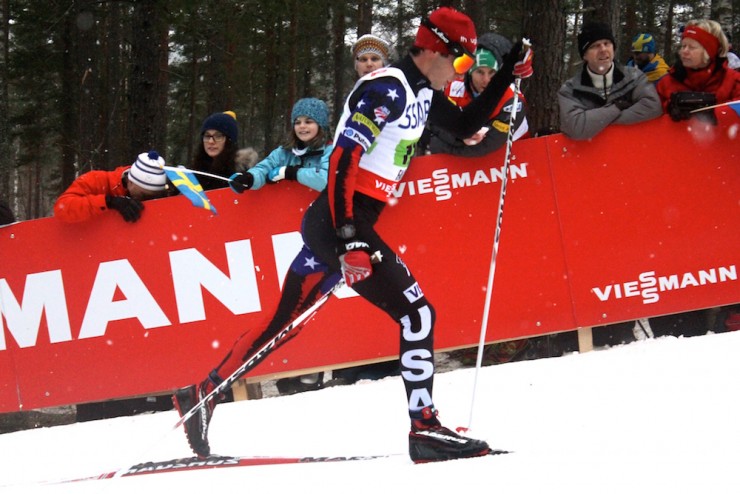
According to Hoffman, his 10 k leg demonstrated a return to form. The American, who expressed discouragement by his results in the Championships skiathlon and 15 k, explained his leg in the relay was a step in the right direction especially for his classic skiing.
“Best race of the season, so a step in the right direction,” Hoffman said. “The last year has been a struggle for classic but today was the best classic skiing I’ve done in a year. It wasn’t spectacular by any means, but It was a step in the right direction.”
With Hoffman’s leg complete Kyle Bratrud took over for the Americans. The Northern Michigan University skier was originally scheduled for one race at the Championships – Wednesday’s 15 k freestyle – but was propositioned by the American coaching staff be the third leg of the relay.
“They asked me if I wanted to be in it and I said sure. I was flattered,” he said of his selection. “It’s another race on the international stage for me so I was all for it. I knew I was going to get my butt kicked around a little bit out there but that’s how you get better, racing these guys.”
Bratrud explained that he hadn’t fully recovered from the 15 k and complained of tired legs that felt better by the last kilometers. At that point Canada’s Ivan Babikov had passed the Minnesota native.
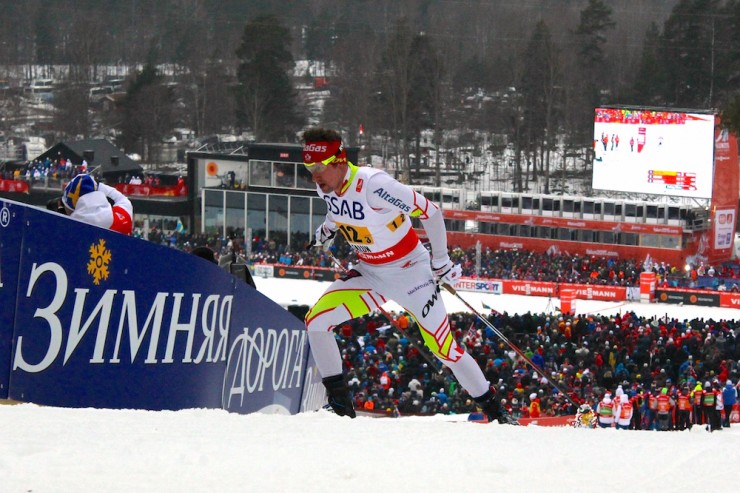
Babikov lost time to Bratrud in the first laps of the third leg, but eventually fought back to bring Canada into 11th place by the relay’s final exchange. Kyle Bratrud entered the exchange 2.4 seconds behind the Canadian in 12th.
“It was not so great,” Babikov said. “The first lap was way too fast for me. Those guys went out way too fast and I couldn’t manage that speed. Then I picked up a bit at the end.”
With Valjas and Hamilton on course, the fight for North American relay supremacy began to heat up. Hamilton surged ahead to ski together with Valjas and the two remained together for the rest of the final 10 k. Both skiers had their sights set on the German and Czech Republic teams roughly 20 seconds ahead, but when it became apparent they were out of reach the fight for 10th position began.
Hamilton said he made a push to leave Valjas behind halfway through the final leg, but once the Canadian remained close behind he reevaluated his strategy and decided to stick behind his friend and competitor until the finish. Valjas, on the on the other hand, continually attempted to ditch Hamilton to no avail.
“I was trying everything,” Valjas said of his leg with Hamilton. “I tried my early attack up the main sprint hill, and he stayed with me. I regrouped, and on the next hill I just really slowed down over the top and tried to sneak attack, just as we started going downhill I started sprinting to see if I could break the draft. That worked a bit, but then he caught up.”
Valjas entered the final meters with Hamilton just behind, and the two strong sprinters gave a final push to claim the last spot in the top-10. Valjas was victorious, beating the American to the line by 1.4 seconds.
“It was a good fight right to the finish. I wasn’t looking back, I knew he was coming,” Valjas said.
The 10th place finish for Canada was an improvement on their 12th place at the 2014 Olympic games. Valjas that he was pleased with the way his team skied, but hoped that the future would bring better results.
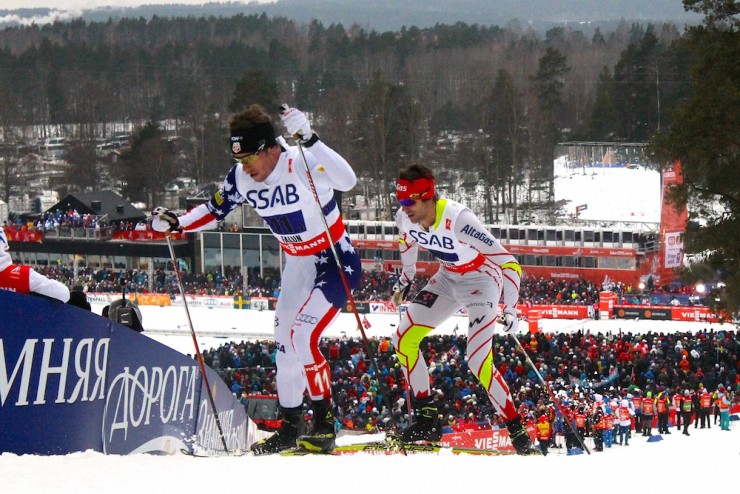
“We’re extremely happy and I think everyone skied extremely well. A few of us including myself know that we can race differently next time,” Valjas said after the finish. “We’re all learning. I’m excited for the next version of this race. See if we can do better, both the Americans and the Canadians. We’re not far from the main group, the sixth and seventh place guys.”
Hamilton said he was proud of his team’s effort and that Friday’s result will be motivation for a better performance in the future.
“All those guys skied awesome legs and I got tagged off in a great position,” he said. “I wish I could have skied that last lap a little better or caught those two guys in front of us so it always gives you goals for the future.”
According to U.S. Ski Team Head Coach Chris Grover, the Americans did especially well considering the team’s level of experience.
“We definitely entered a young team today,” Grover explained. The 2015 Championships is Bratrud’s first and both Bjornsen and Hoffman are relatively young. While Hamilton has anchored several relays, he’s primarily focused on sprinting. “I’m really super proud of how all four of these guys skied. They all kept it super close. We knew this was a course with such a short skate leg that there were teams that were in danger of getting lapped and pulled.”
Lander Karath
Lander Karath is FasterSkier's Associate Editor from Bozeman, Montana and a Bridger Ski Foundation alumnus. Between his studies at Middlebury College in Vermont, he is an outdoor enthusiast and a political junkie.



